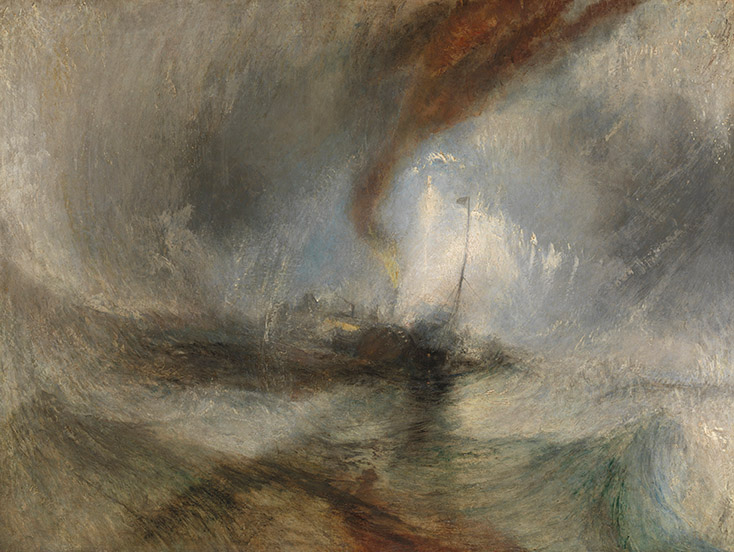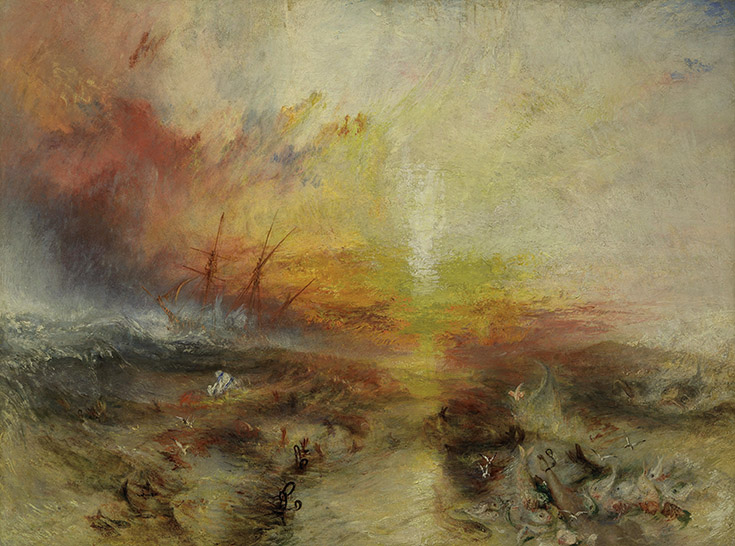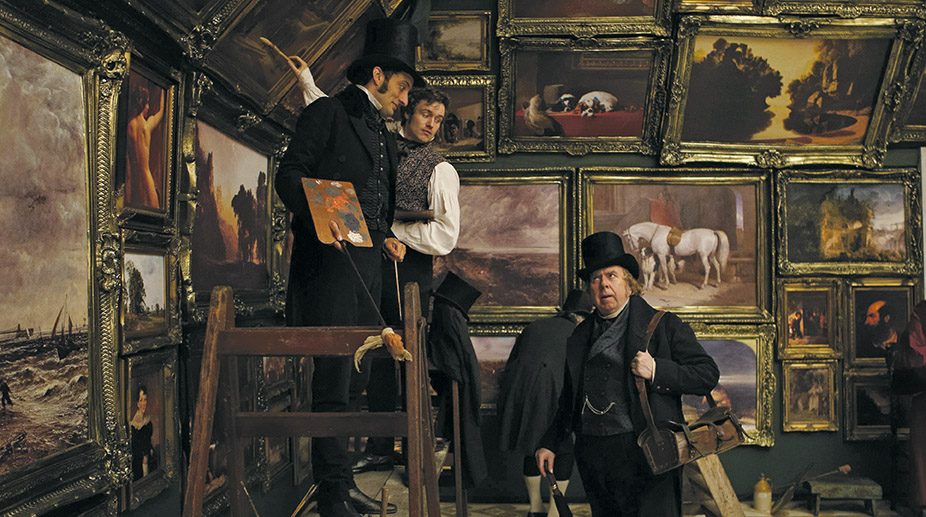Turner’s Modern World Ravishes at the MFA
Exhibition Recasts the Artist as Visionary Historian
CHRISTOPHER VOLPE

Magnificent with content and gorgeously installed, Turner’s Modern World is not to be missed. This exhibition, organized by the Tate, takes us to the heart of Turner’s greatness, demonstrating his continued relevance and invoking what it means to be an artist of one’s time. The more than 40 paintings on display have been curated to show how Turner engaged with the political and social events of his lifetime, including, arguably, the core issue of his era as well as our own: the passing away of an Old-World agrarian, pastoral relationship with nature to make way for the turbulent coming of the modern industrial age.
Turner (1775–1851) was prescient on two related fronts. As a Modern Painter, as Ruskin called him, he pioneered gestural paint-handling, pre-Impressionist atmospherics, even minimalist abstraction (for his own purposes at least). As an artist giving his “evidence” to the world, he balked at painting’s appeal to refinement and pushed toward unruly truths of history, nature, and human aspiration. His pictures increasingly insisted on the validity of personal vision over polite standards of Regency pictorialism.
Take A Disaster at Sea (1835), a painting Turner himself never exhibited. This work’s subject is the storied wreck of the Amphitrite off the coast of France: In a horrific pairing of cowardice and cruelty, the Amphitrite’s entire cargo of 125 female convicts and children died because the captain refused assistance despite the storm, unwilling to land his prisoners anywhere but the intended penal colony of Australia. Turner’s rendering, two years later, casts the event in apocalyptic terms matching the monstrosity of the deed, fusing sea and sky into a churning chaos strewn with the clinging and flailing bodies of drowning women and children.
As early as 1816 critics had complained that Turner, albeit “the ablest landscape painter now living,” indulged in “too much abstractions of aerial perspectives,” making paintings resembling “the first chaos of the world” in which “all is without form and void…. pictures of nothing, and very like.” (William Hazlitt, 1816).

Turner even then put his visions first, and as time went on, he allowed more and more of himself into his paintings. By the time we get to Snow Storm—Steam-Boat off a Harbour’s Mouth in 1842, with its dizzying, off-kilter vortex of ocean, steam, storm clouds and sky, Turner’s pictures might hardly look to his contemporaries like seascapes at all. “Soapsuds and whitewash,” one critic quipped, despite Turner having given them nothing less than mortal combat between natural and mechanical forces. A close look at Snow Storm reveals the unpardonable wildness and agitation with which the Cockney artist scraped, jabbed, smudged, gouged, fingered, and swept paint across the canvas, hinting at a physicality and freedom not seen again until Abstract Expressionism, more than 100 years later.
The painting’s full, nautically precise title is Snow Storm—Steam-Boat off a Harbour’s Mouth making Signals in Shallow Water, and going by the Lead. The Author was in this Storm on the Night the Ariel left Harwich. The autobiographical tagline may be an invention, however. Turner stated: “I did not paint it to be understood, but I wished to show what such a scene was like; I got the sailors to lash me to the mast to observe it; I was lashed for four hours, and I did not expect to escape, but I felt bound to record it if I did.” Despite Turner’s claim, scholars have found no record of a steamboat called Ariel out of Harwich in 1841–42.
Another intensely personal take on contemporary events shows up in Turner’s oil sketch for his masterpiece The Fighting Temeraire tugged to her final berth to be broken up (1839). This painting, one of the many seemingly minor treasures in this show, depicts a formerly glorious jewel of the British Royal Navy being towed up the Thames to be scrapped.
In the sketch, as in the final painting, the steamboat dominates, the once-illustrious Temeraire shimmering in and out of existence, a silvery ghost. Contrasted with the sooty, black-chimneyed steamer towing it to oblivion, the Temeraire resonates as a mournful stand-in for the history and tradition being lost while, as Turner emphasized in the final version, the sun sets on a fading golden age—or, if the viewer prefers, rises on a new, rapidly industrializing world that would also become our own.

At the center of the MFA’s presentation is Turner’s Slave Ship, which the museum owns. Originally titled Slavers Throwing overboard the Dead and Dying—Typhoon coming on, it was supposed to be the consummation of Turner’s career, a picture he hoped would bring people to tears, but for which the critics of 1840 had nothing but scorn. Four years later however, Ruskin, whose father gifted him the painting, influentially came to its defense: “If I were reduced to rest Turner’s immortality upon any single work,” he wrote, “it would be this.”
Now widely considered the greatest British painting of the 19th century, The Slave Ship is a slam in the gut, even from across the room, even amidst a clamoring sea of magnificent Turners. The painting depicts a slave ship, the Zong, whose captain ordered 132 shackled men, women, and children thrown overboard into the shark-teaming waters of the Caribbean after drinking water on board ran low and the captive sickened. Only if the slaves were “lost at sea” (rather than dying of natural causes) could the captain collect insurance on his “cargo.” The incident went to court and galvanized the movement to abolish slavery in the British Empire.
In this version of events, Turner summons a cataclysmic storm to dye the sea and sky the scarlet red of blood and fire. This is a fever dream of hellfire damnation, catastrophe, and terror, nature itself in revolt against a horrific, sinful crime against humanity. Turner conjures a world literally falling apart at the seams, a kind of gulf or trench opening in the ocean at the painting’s center. Sadly, it made Turner the laughingstock of the British artistic establishment. After exhibiting Slave Ship at the Royal Academy, Turner was effectively written off as a crackpot, senile, mad.
Today, as the proliferating books and blockbuster exhibitions, Hollywood movies, YouTube documentaries and “How to paint like” videos attest, Turner continues to cast an ever longer shadow as one of the giants of the history of painting. This show demonstrates why: His themes are our themes; his painterly language is one we readily understand.
We know now why Turner insisted, as few before him had, that his grandest and most significant paintings be true to his experience of the world. It’s his stubborn redefinition of the art form and of the artist’s role itself that truly links Turner’s modern world with ours.
Turner’s Modern World
Museum of Fine Arts, Boston
Through July 10, 2022
mfa.org

Mr. Turner
To enhance the experience of Turner’s Modern World, stream Mike Leigh’s 2014 biopic, “Mr. Turner.” Seeing the movie first illuminates the person and artist against the shifting backdrop of his time. Or, if you see the exhibit first, your understanding of what made Turner masterful and modern will heighten your film experience.
Leigh is best known for his working-class dramas and comedies set in contemporary London. Timothy Spall, who portrays Turner with suitable gruffness, has appeared in five Leigh films, including Secrets and Lies, cited by the Boston Society of Film Critics for Best Director. For his portrayal of J.M.W. Turner (1775–1851), Spall won the Best Actor Award at the 2014 Cannes Film Festival.
The film’s quick scenes and the occasional longer episode depict Turner’s later years, revealing facets of his personality, work, and relationships. Viewers learn of his father’s loyalty; his mother’s tragic demise; and his callous treatment of women and his daughters. We see him painting delicately and fervently; tussling with fellow artists at the Royal Academy; and treading beaches and hillsides, sketchbook in hand. We overhear Queen Victoria dismissing his “dirty yellow mess.”
Exhibition and movie complement each other well. Introductory wall text states “Turner had a knack for marketing,” a point emphasized early in the film. After a quick view of his light-filled studio, the screen goes black, candlelight outlines a few people, a curtain goes up to reveal a small gallery, filled with Turner’s luminous paintings, an irregular yet lucrative way to sell his works. Towards the film’s end, Turner hosts a boastful businessman who offers to buy every piece. Yet mindful of his legacy, Turner has already bequeathed his remaining paintings and watercolors to the British nation.
Other episodes depict a few of modern art’s greatest moments. At the Academy’s Varnishing Day, when the artists finish their paintings, Turner, intimidated by his rival Constable’s masterful landscape, applies at the center of his grey seascape a daub of red paint and departs.
Returning two days later, he shapes the scarlet splotch into a buoy, thus winning over his compatriots. In the second scene (perhaps apocryphal), Turner, seeking authenticity, is lashed to a ship’s mast during a storm in order to experience its fury. In another fraught moment, an old seaman shares with Turner his experience working on a slave ship, “Such terrible suffering I did see; treated like animals.” This conversation portends the creation of one of Turner’s greatest paintings, Slave Ship (1840). Owned by the MFA, this indictment of the era’s abiding scourge of slavery serves as one of the exhibition’s centerpieces.
As the Industrial Age’s arrival impacts Turner’s world, the exhibition features his depictions of steamboats and railways. Likewise, Leigh focuses on the full length of a symbolic steamboat, and shows the strolling painter contemplating a passing train’s billowing black clouds. On a boating excursion under a dark sky, Turner proclaims to his cronies that the future resides in “smoke, iron, steam.”
Working in tandem, the film and exhibition provide insight into Turner’s urgent creativity and staunch engagement with the issues and forces that shaped his turbulent time.
— Jack Curtis
